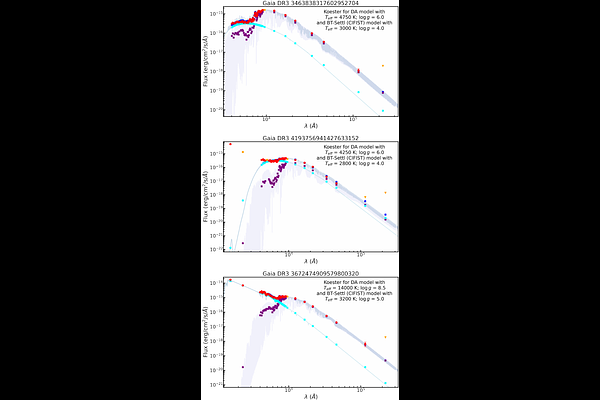A magnitude-limited catalogue of unresolved white dwarf-main sequence binaries from Gaia DR3

A magnitude-limited catalogue of unresolved white dwarf-main sequence binaries from Gaia DR3
Alberto Rebassa-Mansergas, Enrique Solano, Alex J. Brown, Steven G. Parsons, Raquel Murillo-Ojeda, Roberto Raddi, Maria Camisassa, Santiago Torres, Jan van Roestel
AbstractBinary stars containing a white dwarf and a main-sequence star, WDMS binaries, can be used to study a wide range of aspects of stellar astrophysics. We build a magnitude-limited sample of unresolved WDMS binaries from Gaia DR3 to enlarge these studies. We look for WDMS with available spectra whose location in the Gaia colour-magnitude diagram bridges between the evolutionary sequences of single white dwarfs and the main-sequence. To exclude spurious sources we apply quality cuts on the Gaia photometry and astrometry and we fit the SED (spectral energy distribution) of the objects with VOSA (Virtual Observatory SED Analyser) to exclude single sources. We further clean the sample via visual inspection of the Gaia spectra and publicly available images of the objects. We re-fit the SEDs of the finally selected WDMS with VOSA using composite models to measure their stellar parameters and we search for eclipsing systems by inspecting available ZTF and CRTS light curves. The catalogue consists of 1312 WDMS and we manage to derive stellar parameters for 435. This is because most WDMS are dominated by the main-sequence companions, making it hard to derive parameters for the white dwarfs. We also identify 67 eclipsing systems and estimate a lower limit to the completeness of the sample to be ~50% (~5% if we consider that not all WDMS in the studied region have Gaia spectra). Our catalogue increases by one order of magnitude the volume-limited sample we presented in our previous work. Despite the fact that the sample is incomplete and suffers from heavy observational biases, it is well characterised and can therefore be used to further constrain binary evolution by comparing the observed properties to those from synthetic samples obtained modeling the WDMS population in the Galaxy, taking into account all selection effects.